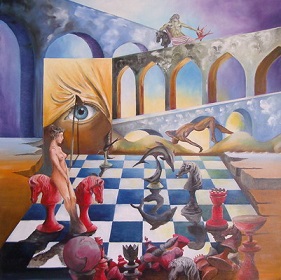Perceiver
Home * Knowledge * Cognition * Perceiver
Perceiver,
an experimental chess program by Michael Barenfeld and Herbert Simon of the late 60s with focus on perceptual processes in problem solving. Perceiver was able to duplicate the eye movements of a chess expert by adhering to the simple relations of attack and defense, based on previously developed routines of the program Mater for detecting those basic chess relations [2].
Fixated Squares
With the simulated fovea centralis fixated on a square of the board, information is acquired peripherally about pieces standing on nearby squares that attack or defend the fixated square, or that are attacked or defended by the piece on that square. Attention is then assumed to switch to one of these nearby squares, and, unless it immediately returns to the square already fixated, causes a saccadic movement to the new square. With the fovea fixated on the new square, the process simply repeats, causing a biased random walk of the fixation point around the board, returning most frequently to those regions of interest where relations among pieces are densest and spending little time on the edges of the board.
MAPP
Kevin J. Gilmartin and Herbert Simon further extended Perceiver into a system called MAPP (Memory-aided Pattern Perceiver) which uses the learning mechanism of EPAM, and reinforced the chunking hypothesis by subjecting MAPP to the same board reconstruction experiment that the human players faced [3] [4].
See also
- Attack and Defend Maps
- CHREST
- Chunking
- EPAM
- Eye Movements
- MAPP
- Mater
- Perception
- Perception - Video
- Square Attacked By
Publicatons
- Herbert Simon, Michael Barenfeld (1968). Information Processing in the Perception of Chess Positions. Carnegie Mellon University, Paper #127
- Herbert Simon, Michael Barenfeld (1969). Information-processing analysis of perceptual processes in problem solving. Psychological Review, Vol. 76, No. 5, pdf, reprinted in Herbert A. Simon (1979). Models of Thought. Yale University Press
- Herbert Simon (1973). Lessons from Perception for Chess-Playing Programs (and Vice Versa). Computer Science Research Review, pdf
- Herbert Simon, Kevin J. Gilmartin (1973). A Simulation of Memory for Chess Positions. Cognitive Psychology, Vol. 5, reprinted in Herbert A. Simon (1979). Models of Thought. Yale University Press
- Herbert Simon, William Chase (1973). Skill in Chess. American Scientist, Vol. 61, No. 4, reprinted (1988) in Computer Chess Compendium, pdf
External Links
- perceiver - Wiktionary
- perceive - Wiktionary
- perception - Wiktionary
- Perception from Wikipedia
- Visual perception from Wikipedia
- Eye movement from Wikipedia
- Agnes Obel - Stretch your Eyes, March 24, 2017, Soundcheck at Wonder Ballroom, Portland, YouTube Video [5]
References
- ↑ Het Oplettende Oog - The Watchful Eye (2002), Schaakkunst van Boldriaan
- ↑ George W. Baylor, Herbert A. Simon (1966). A chess mating combinations program. AFIPS Joint Computer Conferences, reprinted in Herbert A. Simon (1979). Models of Thought. Yale University Press, pp. 181-200, in David Levy (ed.) (1988). Computer Chess Compendium.
- ↑ William Chase, Herbert Simon (1973). Perception in chess. Cognitive Psychology, Vol. 4, No. 1
- ↑ Herbert Simon, Kevin J. Gilmartin (1973). A Simulation of Memory for Chess Positions. Cognitive Psychology, Vol. 5, reprinted in Herbert A. Simon (1979). Models of Thought. Yale University Press
- ↑ Trautonium from Wikipedia
